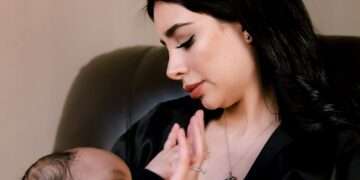Encouraging Breastfeeding -The Best 17 Tips For Your Baby

Encouraging breastfeeding is a wonderful way to provide your baby with essential nutrients and establish a strong bond. Breastfeeding is a wonderful and natural way to nourish your baby while providing numerous health benefits. It’s a unique bonding experience that offers essential nutrients and antibodies. However, it can be challenging for some new mothers. To support and encourage successful breastfeeding, here are some of the best tips and techniques. At first, your baby soaks up sensations without a filter, not yet sure what will be important. Over time, repeated events begin to leave a lasting impression and your baby’s brain organizes and prioritizes the information it receives.
Breastfeeding is a unique and personal journey. It’s essential to remember that every mother-baby duo is different. What works for one might not work for another, so be patient and adaptable. With the right information, support, and perseverance, you can experience the many benefits of breastfeeding for both you and your child. Every moment is a learning opportunity, but your baby’s favorite source of information is you. Not only are you their first model for language and movement but you’re also their emotional barometer. Looking to see how you respond helps your baby make sense of the world.
The best tips for supporting & encouraging breastfeeding-
Here are some of the best tips for baby encouraging breastfeeding:
- Educate Yourself: Knowledge is power. Before giving birth, take breastfeeding classes, read books, and consult with lactation experts. Understanding the benefits and challenges of breastfeeding can help you feel more confident.
- Early Initiation: Begin encouraging breastfeeding as soon as possible after birth. The first hour after delivery is an ideal time to initiate breastfeeding, as your baby is often alert and eager to latch on.
- Skin-to-Skin Contact: Keep your baby skin-to-skin with you right after birth and during feedings. This helps your baby feel secure and encourages breastfeeding.
- Latching Technique: Ensure your baby has a good latch. Your baby’s mouth should cover both the nipple and areola. A correct latch reduces discomfort and promotes effective feeding.
- Seek Support: Reach out to a lactation consultant or join a breastfeeding support group. These resources can provide guidance and reassurance, especially during the early days when breastfeeding can be challenging.
- Nurse on Demand: Breastfeed your baby whenever they show hunger cues. Newborns often feed frequently, which is normal. Encouraging breastfeeding on demand helps establish a good milk supply.
- Position Variety: Experiment with different nursing positions to find what’s most comfortable for both you and your baby. Common positions include the cradle hold, football hold, and side-lying position.
- Pain Management: While some discomfort is normal in the beginning, severe pain is not. If you experience pain or nipple damage, seek help from a lactation consultant to address any latch issues.
- Stay Hydrated and Well-Nourished: Drink plenty of water and maintain a balanced diet to support milk production. Oatmeal, fenugreek, and other galactagogues can also be beneficial.
- Avoid Nipple Confusion: If you’re using a pacifier or bottle, wait until breastfeeding is well-established before introducing them to avoid nipple confusion.
- Breast Compression: During a feeding, gently compress your breast to encourage milk flow. This can be particularly helpful if your baby falls asleep at the breast.
- Pump for Extra Stimulation: If your milk supply is low or your baby is unable to latch, pumping your milk can help maintain and increase supply. Double-electric breast pumps are the most effective.
- Create a Relaxing Environment: Find a quiet, comfortable space for breastfeeding. Dim the lights, play soothing music, or simply relax to make the experience enjoyable for both you and your baby.
- Partner Support: Enlist your partner’s help and support. They can assist with diaper changes, burping, and other caregiving tasks, allowing you to focus on breastfeeding.
- Be Patient: Breastfeeding can be a learning process for both you and your baby. Be patient and give it time. It’s okay to ask for help when needed. Breastfeeding is a good skill that both you and your baby are learning and for some mothers and babies, it is harder than it is for others. Like anything new, it takes time and patience. Relaxation is important for both you and your baby. If you find you are getting frustrated or angry at yourself while you’re trying to breastfeed, stop and try again in a little while. If your baby is distressed, and if it is possible, ask someone to keep them distracted until you are ready to try again. You could also express for this feed and try feeding from the breast for the next feed.
- Know When to Ask for Help: If you face difficulties like low milk supply, engorgement, or persistent latch issues, don’t hesitate to consult a healthcare professional for guidance.
- Trust Your Instincts: You know your baby best. Trust your instincts and respond to their needs.
Why Need Breastfeeding For Baby?
Breastfeeding milk also helps to protect your baby against a range of infections, allergies, and any other medical conditions. It is a good idea to start talking about breastfeeding in early pregnancy. Any fears or concerns that you may have are best addressed early so that you can easily deal with them before you are breastfeeding your baby.
We often expect that Encouraging breastfeeding will come easily because it is ‘natural’, but like any new skill it needs to be learned. It requires time, patience, and plenty of practice, as well as an understanding that it may not always go as planned. Many midwives and lactation specialists are highly skilled in teaching breastfeeding in a way that is very supportive.
Benefits of baby breastfeeding
For your baby:
For Babies:
- Optimal Nutrition: Breast milk is a complete source of nutrition for infants, providing the ideal balance of nutrients, vitamins, and minerals necessary for their growth and development.
- Immune System Support: Breast milk contains antibodies and other immune-boosting substances that help protect babies from infections and illnesses. It provides passive immunity, reducing the risk of infections in the early months of life.
- Digestive Health: Breast milk is easy to digest, reducing the likelihood of digestive problems such as constipation and diarrhea in infants.
- Lower Risk of Allergies and Asthma: Breastfed babies are less likely to develop allergies and asthma later in life.
- Enhanced Cognitive Development: Some studies suggest that breastfeeding may have a positive impact on a child’s cognitive development and intelligence.
- Healthy Weight: Breastfed babies are less likely to become overweight or obese later in life.
- Bonding and Emotional Well-being: The act of breastfeeding fosters a strong emotional bond between the mother and baby, promoting a sense of security and emotional well-being.
- Convenience: Breast milk is always available and at the right temperature, making it a convenient choice for feeding.
- Cost-Effective: Encouraging breastfeeding is cost-effective compared to formula feeding, as it eliminates the need for purchasing formula and bottles.
For Mothers:
- Postpartum Healing: Breastfeeding can help the mother’s uterus contract more quickly after childbirth, reducing postpartum bleeding.
- Weight Loss: Breastfeeding burns extra calories and can aid in post-pregnancy weight loss.
- Hormonal Balance: It helps the mother’s body return to its pre-pregnancy hormonal balance more quickly.
- Reduced Risk of Certain Diseases: Breastfeeding is associated with a reduced risk of breast cancer, ovarian cancer, and type 2 diabetes in mothers.
- Economic Savings: As mentioned earlier, breastfeeding is cost-effective, saving money on formula and feeding supplies.
- Convenience: Breastfeeding eliminates the need for preparing and cleaning bottles, making it a more convenient option.
- Environmental Impact: Breastfeeding has a lower environmental impact compared to formula production and packaging.
- Bonding: Breastfeeding promotes a strong emotional bond between the mother and baby, enhancing the maternal-child relationship.
It’s important to note that while encouraging breastfeeding offers numerous benefits, not all mothers are able or choose to breastfeed. The decision to breastfeed is a personal one, and formula feeding is a safe and healthy alternative when necessary. Ultimately, what matters most is the well-being and health of both the mother and the baby.
Breastfeeding gives you more opportunity to can connect with your baby in a profound and deeply satisfying way. Encouraging breastfeeding is a physical and emotional bond that stays with you for many years afterward.
Improve The Chance Of Successful Breastfeeding-
1. Breastfeeding Can Ideally Start Immediately After The Baby Is Born.
To promote mother-baby bonding which is skin-to-skin contact, breastfeeding should start immediately or within half an hour of birth. It increases the likelihood of exclusive breastfeeding with sufficient breast milk supply. As soon as breastfeeding starts, the baby spontaneously learns how to latch and the mother understands when the baby seeks the breast milk.
2. Mother Should Apply Appropriate Encouraging Breastfeeding Techniques.
To follow the appropriate position and techniques, the mother needs to sit upright position. The baby’s head and body should be held in a straight line. The baby’s head and neck should not be twisted. The baby faces the breast with the nose opposite the nipple. The mother has to hold the baby as close to the breast as possible and support the base of the baby’s head with her thumb and fingers. The baby’s head slightly extends, so the nipple is aimed at the roof of the baby’s mouth and lightly touch the baby’s lip with the nipple.
When the baby’s gum touches the areola that consists of milk sinuses, the baby’s tongue is placed automatically under the areola and the baby starts latching without lip compression. A sign of good attachment is the baby opens the mouth wide with lips flanged out instead of being tucked in. Pauses are noticed in between suckling. During breastfeeding, the baby swallows occasionally and it is an excellent sign for milk ingestion. When the mother is away from the baby, the mother has to preserve breast milk production.
During breast milk pumping, a pump-friendly environment for breast milk secretion and collection is crucial. The mother should be able to collect breast milk at least 8 times per day with a certain amount of milk. During the first 2 weeks, the daily amount of encouraging breastfeeding milk should be greater than 500 ml. In addition, during the first 2 weeks, the amount of breast milk in each day should be recorded in order to evaluate whether it is sufficient for the baby’s needs.
3. The Baby Must Be Breastfed Only
After birth, exclusive breastfeeding is highly recommended for at least 6 months. Water, foods, or other fluids are not allowed unless there are certain medical indications. Since the brain and neurological system quickly develop while the stomach remains small, a number of researches indicate that breastfeeding improves the brain development of infants. Breast milk is primarily composed of water, a high amount of nutrients, vitamins, proteins, fats, and immune-boosting antibodies which are sufficient for a baby to grow.
Breast milk provides all the nutrition your baby needs for the first six months of life and can give your baby most of their nutrition for the first year of their life and beyond.
How can I encourage my breastfeeding to be better?
Be sure the baby is positioned and latched correctly. So can Offer both breasts at each feeding. Try breast compression during the feeding to can help drain the breast. Pump immediately after breastfeeding during the day.
Breastfeeding helps protect your baby from getting sick later
Breastfeeding’s protection against illnesses and diseases lasts beyond when your baby is nursing or drinking pumped milk. Studies have shown that breastfeeding can reduce a child’s risk of developing certain childhood cancers, such as leukemia. Scientists don’t know exactly how breast milk reduces the risk, but they think antibodies in breast milk may give a baby’s immune system a boost.
Encouraging breastfeeding may help your child avoid some diseases that strike later in life, such as type 1 and type 2 diabetes, high cholesterol, and inflammatory bowel disease. In fact, preemies given breast milk as babies are less likely to have high blood pressure by the time they’re teenagers. Researchers have also found that breastfeeding protects against Crohn’s disease and ulcerative colitis.
Conclusion
Breastfeeding is a unique and personal journey. It’s essential to remember that every mother-baby duo is different. What works for one might not work for another, so be patient and adaptable. With the right information, support, and perseverance, you can experience the many benefits of breastfeeding for both you and your child.
Remember that Baby breastfeeding is a personal journey, and encouraging breastfeeding is important to do what feels right for you and your baby. Whether you exclusively breastfeed or use a combination of breastfeeding and formula, what matters most is the health and happiness of both you and your baby.
kidsmodelistamagazine





























